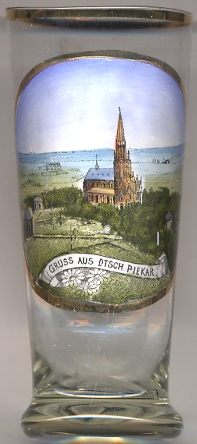

|
| POLSKA | POLAND |
| województwo: Śląskie | voivodship: Silesia |
| miasto na prawach powiatu: Piekary Śląskie | city: Piekary Śląskie |
 Piekary Śląskie (in German: Deutsch Piekar) is situated at an elevation of 200 m in the
Silesian Highlands on the Brynica river, about 16 km north of the Silesian vovodship's capital,
Katowice. The municipality has a population of about 57,500 (2012).
Piekary Śląskie (in German: Deutsch Piekar) is situated at an elevation of 200 m in the
Silesian Highlands on the Brynica river, about 16 km north of the Silesian vovodship's capital,
Katowice. The municipality has a population of about 57,500 (2012).
Piekary/Piekar was already mentioned in the 12th century. The first church and parish was established between 1308 and 1318. Since its foundation, the village was located within the territory of the Silesian Piasts and originally was a settlement of Polish bakers from the castellany of Beuthen (Bytom). In 1369, during the period of the German eastern colonisation, the prefix Deutsch ('German') was added to the name Piekar (Dewsche Bechker). A rapid development started in the 14th/15th century due to silver and lead mining. In 1683 the Polish king Jan III Sobieski stayed briefly in Piekary on his way to the relief of Vienna. His successor as Polish king, August II ('the Strong'), Friedrich August I as Elector of Saxony, visited Piekary on his way to Cracow to accept the Polish crown; it was here in Piekary that he converted to Catholicism in the local church and also swore the 'pacta conventa', the formal agreement between the newly elected Polish king and the Polish nation, i.e. the szlachta (nobility) of the Polish-Lithuanian Commonwealth. Mining for zinc began in 1704 and from then on Deutsch Piekar became an industrial town. Following the Silesian uprisings of 1919–1921, where the Polish population of Piekary participated, a referendum was held. Since 86% of the population voted for joining the Polish state, Piekary was handed over to Poland in 1922 and was renamed Piekary Wielkie. In 1934 Piekary Wielkie was merged with the neighbouring community of Scharley (Szarlej); one year later the new municipality was renamed Piekary Śląskie. In 1939 it was decided to elevate the municipality to the status of a town; however, due to World War II, this was not realised so that it took until 1947 that Piekary Śląskie officialy gained the new status. Piekary Śląskie also is an important pilgrimage, the second-most visited Marian shrine of Poland after Częstochowa.
The  church of the Resurrection of Jesus (kościół Zmartwychwstania
Pańskiego) on the calvary of Piekary Śląskie. The church was built in Gothic revival style in
1893–1896 by the architect Julius Kapacki. The calvary had been created in the 1870s on Cerwica hill and consists
of 14 chapels for the Stations of the Cross and 15 rosary chapels.
church of the Resurrection of Jesus (kościół Zmartwychwstania
Pańskiego) on the calvary of Piekary Śląskie. The church was built in Gothic revival style in
1893–1896 by the architect Julius Kapacki. The calvary had been created in the 1870s on Cerwica hill and consists
of 14 chapels for the Stations of the Cross and 15 rosary chapels.
[https://de.wikipedia.org/wiki/Piekary_Śląskie, https://en.wikipedia.org/wiki/Piekary_Śląskie,
https://en.wikipedia.org/wiki/Pacta_conventa_(Poland);
https://de.wikipedia.org/wiki/Piekary_Śląskie, http://fotopolska.eu/Piekary_Slaskie/b992,Kosciol_Zmartwychwstania_Panskiego.html]
![[scale]](lineal.jpg)